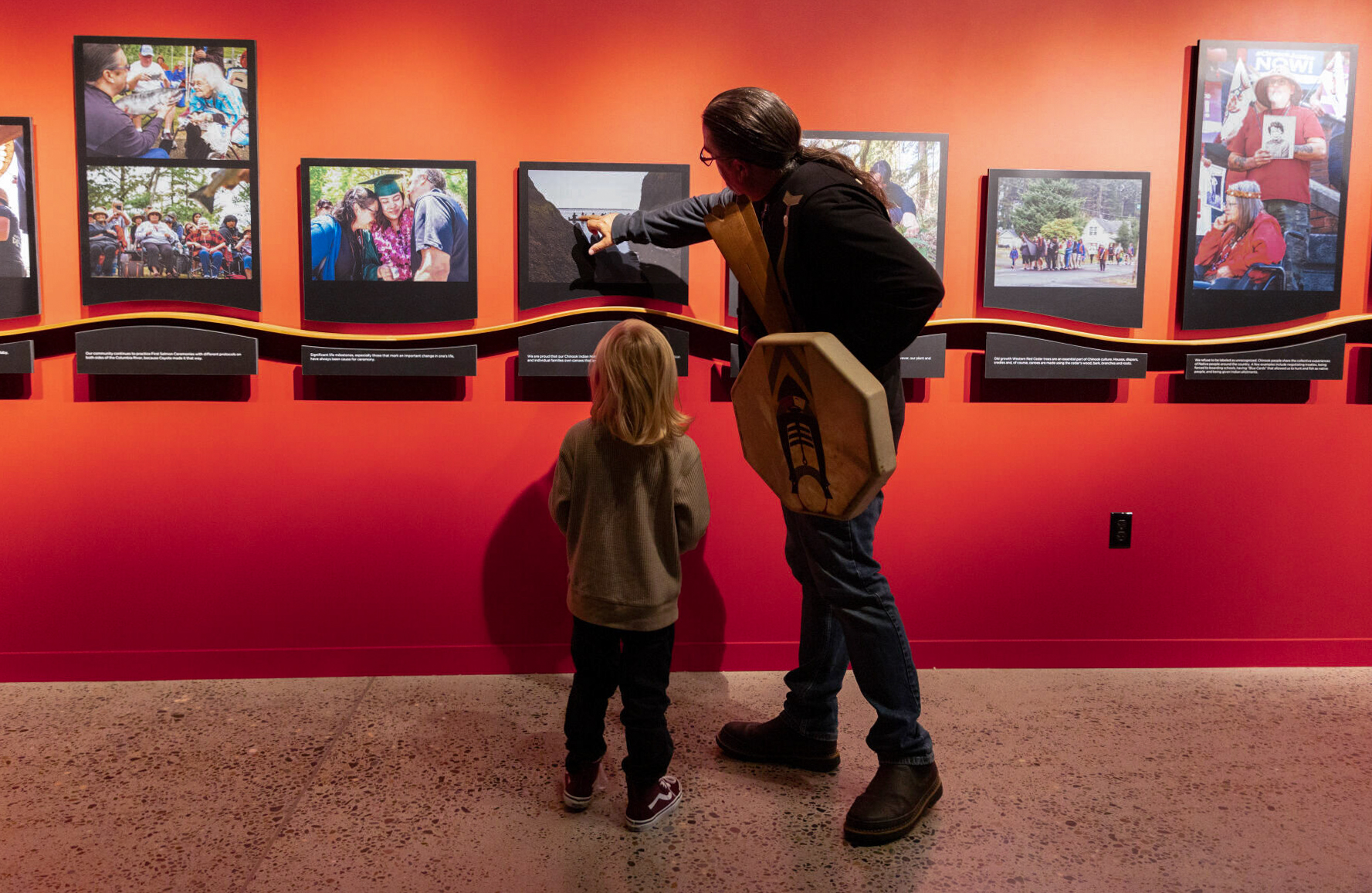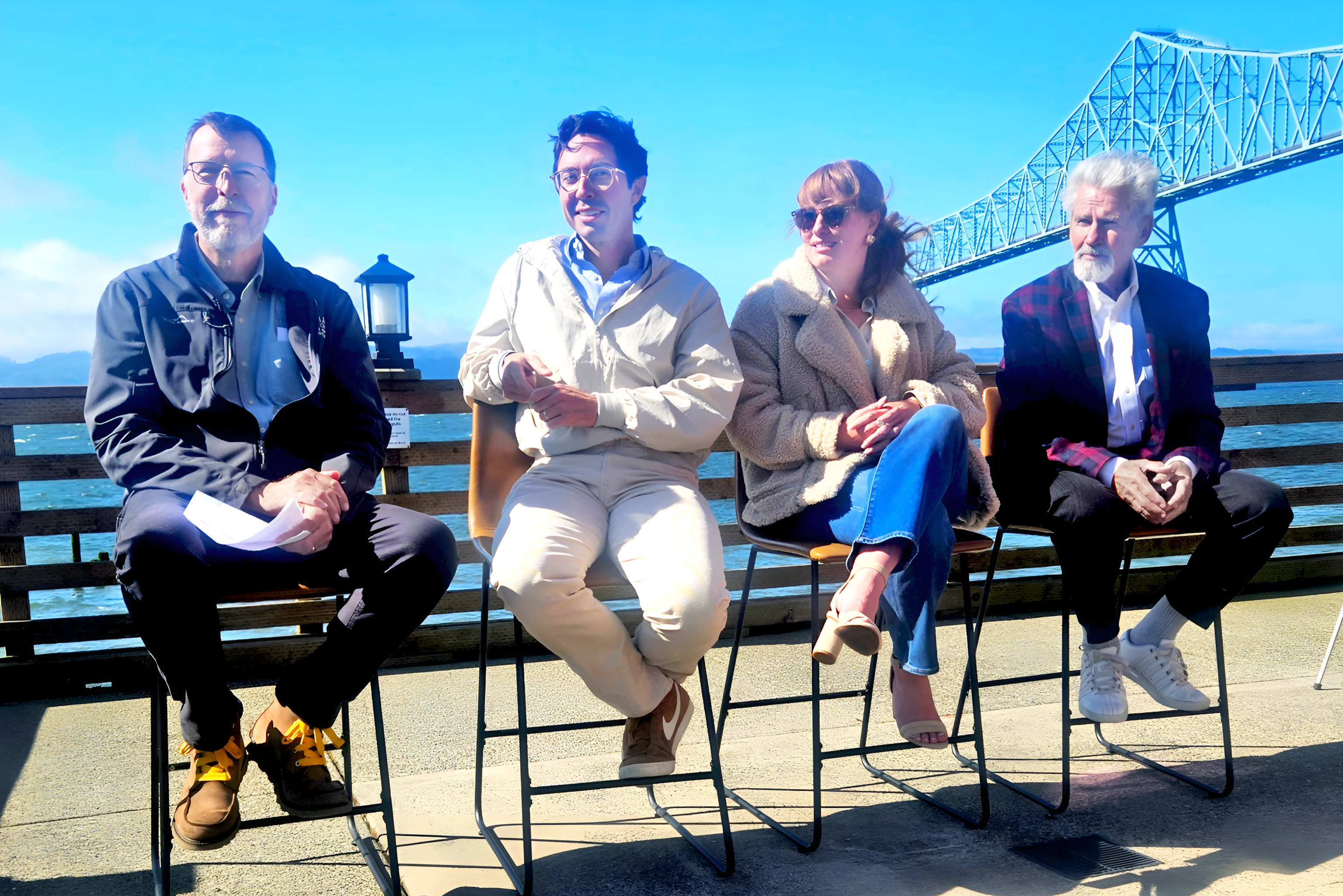‘This is our place’
Published 10:00 am Friday, September 13, 2024

- A Chinook canoe travels across the Salish Sea during the Tribal Canoe Journey. (Amiran White)
One photograph shows a mother and her 6-year-old daughter as they harvest nettles to cook and make tea with.
In another, set against a red gallery wall backdrop at the Columbia River Maritime Museum, a woman leads a group of dancers in traditional regalia.
They’re doing a welcome dance, explained Tony Johnson, chairman of the Chinook Indian Nation, during an opening reception Thursday at the Astoria museum for “ntsayka ilíi ukuk: This is Our Place,” the new exhibit both images belong to. Johnson led tribal members in drumming and singing the accompanying “Willapa Bay Welcome Song.”
Johnson spoke to the significance of the exhibit, which includes more than 20 photographs by Amiran White, who has been documenting the Chinook for more than eight years.

Chinook Indian Nation chairman Tony Johnson points to a photo by Amiran White in a new exhibit at the Columbia River Maritime Museum. (Lukas Prinos/The Astorian)
“They wanted us to leave our country. That was the, quote, negotiation, was ‘you will sign this document and leave your land.’ Well, ntsayka ilíi ukuk, ntsayka ilíi ukuk, this is our place,” Johnson said. “The treaties we negotiated kept us right here.”
Bruce Jones, the museum’s executive director, said that he and museum curator Jeff Smith met with Johnson and members of the Chinook Cultural Committee to plan the exhibit, which also includes a video projection with the faces of tribal members.
“It was the idea, the very generous idea, of the cultural committee that this exhibit would serve as a welcome, a welcome by the Chinook Indian Nation to their land and to our museum,” Jones said.
That welcome offers a look at tribal life in the balance of tradition and the everyday.
White captures cultural events like the First Salmon Ceremony, Chinook Winter Gathering and Tribal Canoe Journey. But she’s also been present for birthdays, graduations, first tattoos and sparklers on the beach.
“Amiran … she’s a great friend, she’s really family and part of our Chinook community, and she’s given an incredible gift to the community,” Johnson said. “She’s watching generations of kids come up and the work that we’re doing to perpetuate our existence here.”
White became interested in photographing Chinook culture after hearing Johnson speak at the University of Oregon about the ongoing struggle to obtain federal recognition, a consequential designation that affects access to health care, housing and educational opportunities.
“When I heard that story, I started asking questions and finding out more,” she said.
A documentary photographer originally from the United Kingdom, White has worked as a photojournalist for newspapers in Oregon, Pennsylvania and New Mexico, and has traveled throughout Central America, India and Europe as a freelance photographer. She has received numerous honors, including a nomination for the Pulitzer Prize.
She said documenting Chinook life is the longest project she’s worked on.
“It truly is a privilege and an honor to be able to work this closely with the community. There’s a certain amount of trust and relationship-building,” White said. “All of the images mean something to me.”

Mary Johnson, right, leads a Chinook welcome dance. (Amiran White)
Also being added to the exhibit are three canoes, which will leave and then return to the museum after being used on the water.
“These are not dusty artifacts that have been in a museum warehouse for decades. These are living canoes, built and used every year by Chinook families,” Jones said. “They will come to life and then they’ll come back into the museum. Every year, they’ll come and go as needed.”
The display comes ahead of other plans for the museum, which was recently awarded a $250,000 grant from the Roundhouse Foundation.
Another canoe, crafted by Tofino, British Columbia, carver Joe Martin, is being planned as a centerpiece of Cedar and Sea, an exhibit focused more broadly on Indigenous maritime cultures along the Pacific coast — from British Columbia to southern Oregon — which is expected to open in November.
The museum is also looking ahead to future collaborations with the Chinook Indian Nation on displays for Mariners Hall, a new exhibit hall expected to open in the summer of 2026 that is part of a $30 million expansion project.
“It means an awful lot for us to come up a little bit above the surface and show you these photos, to know that in the expansion of the museum, there’s another permanent space for telling the Chinook story,” Johnson said.
“That song, as an example, that dance, whatever it is, the words that I was sharing with you … those are our wealth, that’s what we have. We don’t have a reservation. We don’t have proper federal recognition,” he said. “There is so much that has been taken from Chinook and Chinook folks, so to us, these things are incredibly precious.”









